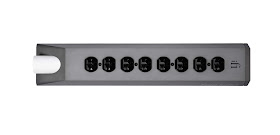パート2:電源ノイズ。これこそが真の災いのもと。
Part 2: Mains noise. A real bane.Power supply noise is the bane of every audio system. There are always multiple sources of noise and they come from two main sources – inside and outside.
External noise is all around
電源ノイズは、あらゆるオーディオ・システムの災いのもとです。ノイズの発生源は常にいくつもありますが、その主要な発生源は2つ:内側と外側です。
外部ノイズは周囲のあらゆる場所に存在します。
This chart shows that noise is anywhere and everywhere and some of it inevitably ends up in the mains that supplies the audio system. We can do little about most of these as they come from sources found in everyday life such as radios or mobile phones.
As these are wireless in nature, they are very difficult to deal with at the source, so we need to address the symptom.
この図を見ると、ノイズがありとあらゆる場所に存在し、中にはどうしてもオーディオ・システムに給電する電源に侵入してくるものがあることがわかります。こういったノイズに関しては、私たちには打つ手がほとんどありません。というのも、それらは、ラジオや携帯電話といった日常生活に必要な機器が発生源となっているからです。
こういった機器は無線で動作するので、機器側でノイズを抑えるのは非常にむずかしく、そのためこの症状に対処する必要が生じるのです。
The next chart shows the ‘local’ noise sources found in and around an audio system.
以下の図は、オーディオ・システムの内外に見出される「ローカル」ノイズを示しています。
Local noise comes from hi-fi components
These sources of noise are found in hi-fi systems and come from three main sources:
- AC mains power supplies
- Switch-Mode Power Supplies
- Digital circuitry.
ローカル・ノイズはハイファイ・コンポーネントから発生します
これらのノイズの発生源はハイファイ・システム中に見出すことができますが、それには3つの主要発生源があります:
- AC電源
- スイッチング電源
- デジタル回路
(From left to right:)
The first set of noise sources (10k > 10MHz) relate to AC supply rectifiers and their harmonics caused by Linear Power Supplies (LPS). Yes, they make a noise!
The second set of noise sources (67k > 200 MHz) is caused by Switch-Mode Power Supplies (SMPS). By comparison, these harmonics run in the higher frequencies.
The third set of noise sources (8 MHz > 500 MHz) is caused by digital circuitry, clocks and their harmonics. And this type of noise exists in the most upper frequencies.
You can see from the chart that the concentration of noise is from 30kHz upwards (the lower the dB, the less influential is the noise).
(左から右へ)
第1のノイズ源(10kHz>10MHz)は、AC電源の整流器と、リニア電源(LPS)によって生じる高調波に関係したものです。そうです、これらがノイズを発生させるのです!
第2のノイズ源(67kHz>200MHz)は、スイッチング電源(SMPS)が原因です。比較すると、これらの高調波は、もっと高い周波数で発生していることがわかります。
第3のノイズ源(8MHz>500MHz)は、デジタル回路、クロック、そしてそれらの高調波が原因となっています。また、このタイプのノイズは、いちばん高い周波数帯域に存在しています。
この図を見ると、ノイズが30kHz以上の帯域に集中しているのがわかります(dBが低くなるほど、ノイズの影響も低くなります)。
LPS vs SMPS
It is worth noting that, as much as LPS designs get a good reputation and SMPS designs get a bad reputation, the reality is somewhere in between. And the situation is dynamic.
LPS designs are on the whole good and, on average, are quieter than poorly designed SMPS power supplies (which tend to be more for charging mobile phones and are not optimised for noise). This is why LPS is often perceived as superior to SMPS.
LPS対SMPS
LPS方式は評判が高く、SMPS方式は評判が悪いのが現状ですが、現実はその中間になるということは、覚えておく価値があります。しかもこの現状は、流動的です。LPS方式は全体的には良好で、一般的には設計の貧弱なSMPS(携帯電話を充電したり、ノイズ対策が取られていないと、ますますその傾向が強まります)よりも静かです。LPSがSMPSよりも優れていると認知されているのは、これが理由であることがよくあります。
Hybrid and electric cars used to be shunned, yet they are now all the rage. We believe the same is happening for SMPS. These are now more environmentally-friendly and consume far less power. Whereas all SMPS used to be ‘noisy’, we are one of the few companies who have broken down the SMPS into its constituent parts and fundamentally re-designed it for audiophile use ie super low- noise. The iPower is the ‘Model 3’ of SMPS power supplies.
ハイブリッドの電気自動車は、以前は避けられていましたが、今では大人気です。SMPSにもこれと同じことが起きていると、私たちは信じています。環境により優しく、電力消費も少ないからです。以前はSMPSはすべて「ノイズを発生する」ものでしたが、SMPSを構成部品の段階にまで分解して基本から設計し直し、オーディオファイルにも使用できるようにする、つまり超低ノイズにするという会社がいくつか出現しています。弊社もそのひとつで、iPowerはSMPS電源の「モデル3」なのです。
Nevertheless, not everyone has an iPower at their disposal. It is therefore important to be able to effectively deal with normal SMPS noise which can be quite severe.
The next section explains which aspects of the PowerStation target the different groups of noise and how this compares with the common approach.
Part 3 shows how active beats passive everytime.
とはいえ、だれもがiPowerを自由に使えるわけではありませんから、非常に深刻になる可能性もある通常のSMPSノイズを効果的に処理することができることが重要になります。
次のパート3では、PowerStationのどの側面が様々なノイズ・グループを標的にし、これが一般的なアプローチとどう異なるかを説明します。
パート3では、「アクティブ」が常に「パッシブ」に優ることを示します。(続く)



















